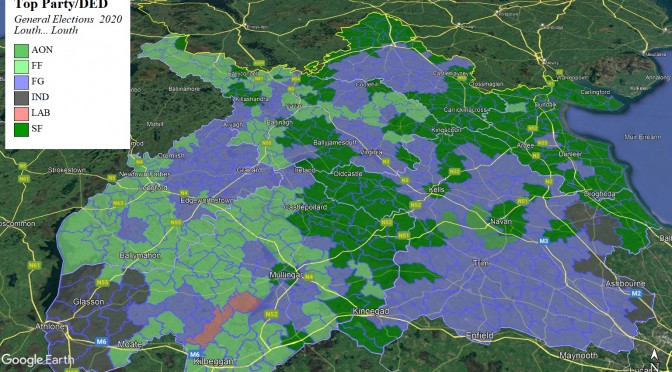In this post, I will be gradually working through the possible permutations of constituencies that the recently formed Electoral Commission might consider.
Unfortunately I’m slightly shooting blind, as the Terms of Reference merely state that “the total number of members of the Dáil, subject to Article 16.2.2° of the Constitution, shall be not less than 171 and not more than 181”. Apparently, the precise number of members the Dáil will not be set until after the Central Statistics Office releases the final population figures (sometime in the summer months) and will not be revealed until the Constituency Review report is released probably in the Autumn.
However, there seems to be a general concensus amongst people wiser than myself that the final number is likely to be somewhere between 176 and 181 in order to “future-proof” whatever scheme of constituencies is arrived at.
Accordingly, I have decided to ensure that my constituency examples below (examples – not proposals) would be within the permitted 5% variation from the National average of Population per TD for both 178 and 180 seat models.
Just to reiterate that these are examples of what the Electoral Commission MIGHT do, rather than what they WILL do – or indeed, what I think they SHOULD do.
VARIANCE
The below table shows the population limits (positive or negative) that for constituencies to be valid. Each constituency has to have a Population per TD ratio within 5% of the National Average.
TABLE 1 – PERMITTED VARIATIONS IN POPULATION FOR CONSTITUENCIES
| MAGNITUDE | 178 | 180 | ||
| Minimum | Maximum | Minimum | Maximum | |
| 3 seats | 82,034 | 90,669 | 81,123 | 89,662 |
| 4 seats | 109,379 | 120,892 | 108,164 | 119,549 |
| 5 seats | 136,724 | 151,116 | 135,204 | 149,436 |
TERMS OF REFERENCE
The Terms of Reference for the Electoral Commission are as follows.
- the total number of members of the Dáil, subject to Article 16.2.2° of the Constitution, shall be not less than 171 and not more than 181*;
- each constituency shall return 3, 4 or 5 members;
- the breaching of county boundaries shall be avoided as far as practicable.
- the reference to county boundaries shall be deemed not to include a reference to the boundary of a city or any boundary between any 2 of the counties of Dún Laoghaire-Rathdown, Fingal and South Dublin.
- each constituency shall be composed of contiguous areas;
- there shall be regard to geographic considerations including significant physical features and the extent of and the density of population in each constituency; and
- subject to the above matters, the Commission shall endeavour to maintain continuity in relation to the arrangement of constituencies.
The two important terms for me are Numbers 3 and 7, as logically interpreted it means that the integrity of county boundaries is prioritised over the continuity of current Constituency boundaries – including presumably those where county boundaries are breached.
As regards Number 2, I think it’s regrettable that larger constituencies are not permitted – besides allowing for a better share of representation, there is a reasonable case for their use in larger counties (ie Galway) or indeed in large cities (ie Dublin and Cork)
LEINSTER
I’m going to examine the Leinster counties in three distinct groups :
- Carlow, Kildare, Kilkenny, Laois and Offaly
- Cavan, Longford, Louth, Meath, Monaghan and Westmeath
- Wexford and Wicklow
The more eagle-eyed amongst you will have noticed that two Ulster counties are mentioned above. This is because the previous Boundary Commission crossed a provincial boundary to add seven District Electoral Divisions in Meath to Cavan-Monaghan.
CAVAN, LONGFORD, LOUTH, MEATH, MONAGHAN AND WESTMEATH
Firstly, the reasoning behind choosing to group these six counties.
Of the five constituencies encompassing these counties, two are in Meath, two (Louth and Cavan-Monaghan have areas in Meath within their boundary and Longford-Westmeath borders a portion of Eastern Westmeath that lies within the constituency of Meath East.
TABLE 2 – POPULATION BY CONSTITUENCY
| CONSTITUENCY | POPULATION | 178 SEATS | 180 SEATS |
| Cavan-Monaghan | 150,238 | 5.22 | 5.28 |
| Longford-Westmeath | 133,056 | 4.62 | 4.67 |
| Louth | 167,012 | 5.80 | 5.87 |
| Meath East | 98,662 | 3.43 | 3.47 |
| Meath West | 98,935 | 3.44 | 3.48 |
In fact Meath and Westmeath were joined together as a constituency for the four elections between 1937 and 1944 – it consisted of the whole county of Meath as well as much of Westmeath bar Athlone and its hinterland which went into Athlone-Longford. Despite the political upheavals of the time – the revival of the Labour Party, the appearance of Clann Na Talmhan – the constituency consistently returned three Fianna Fáil and Fine Gael TDs at each of the four elections.
TABLE 3 – POPULATION BY COUNTY
| COUNTY | POPULATION | 178 SEATS | 180 SEATS |
| Cavan | 81,201 | 2.82 | 2.85 |
| Longford | 46,634 | 1.62 | 1.64 |
| Louth | 139,100 | 4,83 | 4.89 |
| Meath | 220,296 | 7.65 | 7.74 |
| Monaghan | 64,832 | 2.25 | 2.28 |
| Westmeath | 95,480 | 3.33 | 3.37 |
Looking first at the County population table above, it’s immediately apparent that both Cavan and Monaghan counties and also Longford and Westmeath counties are both now within the permitted limits of variance to each standalone five seat constituencies without any boundary breaches. This means that the seven DEDs in North Meath previously in Cavan-Monaghan can now return to the county and also that Meath West should cede the territory it had in Westmeath.
Louth also has just about enough population to be a standalone five seater without the two DEDs in Meath (St Mary’s and Julianstown), which would allow a possible 8 seats in Meath. The major caveat here is that a sizeable portion of the southside of Drogheda lies on the Meath side of the border.
Also the Louth Constituency now has just about enough population for six seats, which means it can be split into two three seaters.
This leaves County Meath which – minus the two DEDs in the Louth constituency – has just about enough for seven seats.
The question is how do you distribute those seats.
Below is a map of the Meath constituencies as currently constituted (within Meath). The white line is the boundary between Meath East and Meath West, the area north of the light red line is currently in Cavan-Monaghan and the area north of the dark red line is in the Louth constituency (It contains the southern part of Drogheda as well as Julianstown, Laytown and Bettystown).
MAP 1 – CONSTITUENCIES IN COUNTY MEATH
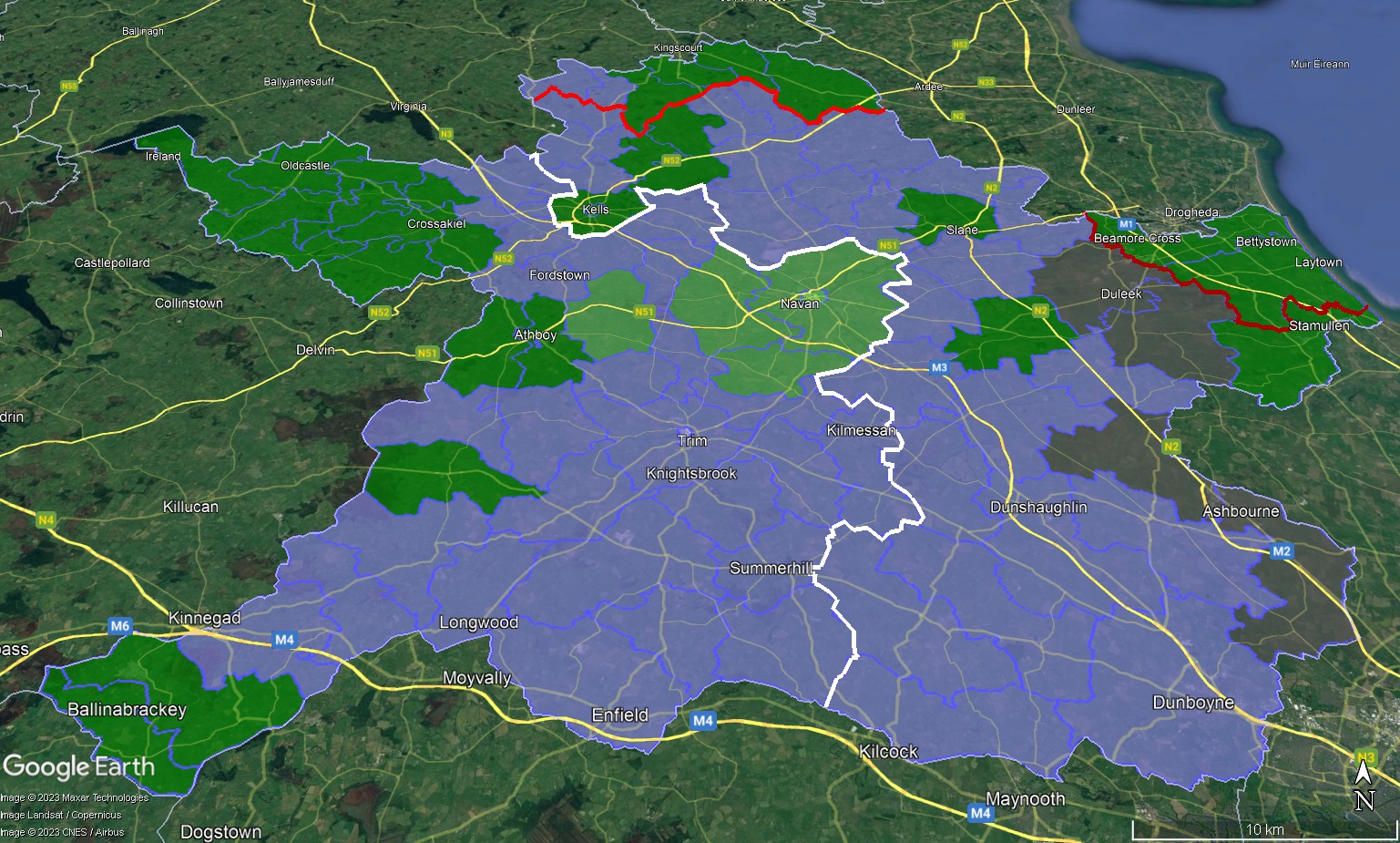
At the moment, Meath East has a population of 98,662 in the 2022 census; adding in the seven DEDs currently in the Cavan-Monaghan Constituency makes that 102,772. The constituency of Meath West (within the county of Meath) has a population of 89,467.
Looking at Table 1, we can therefore make the following calculations about the limits on how much population each constituency can gain and lose to share 7 seats whilst both remaining within the permitted variations of Population per TD
TABLE 4 – POSSIBLE CONFIGURATIONS IN MEATH
| CONSTITUENCY | CONFIGURATION | |
| M. East 4, M. West 3 | M. East 3, M. West 4 | |
| Meath East | Minimum Gain +6,607 | Maximum Loss -20,738 |
| Meath West | Maximum Loss -7,433 | Minimum Gain +19,912 |
As can be seen, making Meath East a 4 seater and Meath West a 3 seater requires a much smaller transfer of population; the trade-off is that the “window of opportunity” for a population transfer is pretty small – a few hundred either side of seven thousand. This is likely to limit the choice of otherwise suitable DEDs.
Alternatively, a much larger transfer would be required to make Meath West a 4 seater.
CAVAN-MONAGHAN (5 seats)
The constituency of Cavan-Monaghan would simply consist of the counties of Cavan and Monaghan. There are three sizeable towns in the constituency, Cavan in the centre of the same county, Monaghan in the north of its county and Carrickmacross in South Monaghan. Other smaller towns include Bailieborough, Kingscourt and Virginia, all in east Cavan.
TABLE 5 – CAVAN-MONAGHAN CONSTITUENCY DEDS
| COUNTY | DISTRICT ELECTORAL DIVISIONS | POPULATION |
| Cavan | ALL | 81,201 |
| Monaghan | ALL | 64.832 |
The new Cavan-Monaghan would be exactly the same as the 5 seat Cavan-Monaghan constituency that was used in elections from 1981 until 2011. In 2016, the constituency was reduced to a four-seater as much of west Cavan was moved into Sligo-Leitrim. It was restored as a five-seater in 2020 with the addition of seven DEDs in North Meath. In 1977, Cavan-Monaghan was also a five seater but with a part of Monaghan in the Louth constituency.
Lots of interesting history in the Cavan-Monaghan constituency and the Cavan and Monaghan constituencies that preceded it prior to 1977.
In the uncontested 1921 election, three names that were to become famous (or infamous, depending on your perspective) in Irish history were returned for Sinn Féin – Ernest Blythe, Eoin O’Duffy and Sean MacEntee. Both the Cavan and Monaghan constituencies had prominent Orangeman Independent TDs between the 1920s and 1940s – in 1933 Alexander Haslett defeated Ernest Blythe of Cumann Na Gaedhal with the aid of Fianna Fáil transfers.
Cavan also played host to a Clann na Talmhan TD (Patrick O’Reilly) and Clann na Poblachta TD (James Tully). Fine Gael didn’t win a seat in any of the elections in the 1940s – in 1944 they didn’t even contest. Similarly in Monaghan, they didn’t contest any election between 1943 and 1951 while James Dillon was in the Independent ranks. 1951 in Monaghan was a strange election, there were only 4 candidates – 2 Fianna Fáil and 2 Independents. And the two FF candidates got exactly the same number of first preferences – 6,802.
Fianna Fáil took two of the three seats in Monaghan at every election from 1937 until 1957 when Eighneachain O’hAnluain was elected for Sinn Féin. Twenty-four years later Hunger-Striker Kieran Doherty won a seat in 1981 before dying two months later.
Fine Gael took two out of three seats in both Cavan and Monaghan in 1969. Billy Fox won the second FG seat in Monaghan; he was murdered in 1974 by the IRA.
In 1987 Fianna Fáil won three of the four available seats when Tom FitzPatrick was returned automatically as Ceann Comhairle. Ten years later Caoimhin O’Caolain became the first Sinn Féin TD returned to the Dáil in modern times.
MAP 2 – PROPOSED CAVAN-MONAGHAN CONSTITUENCY
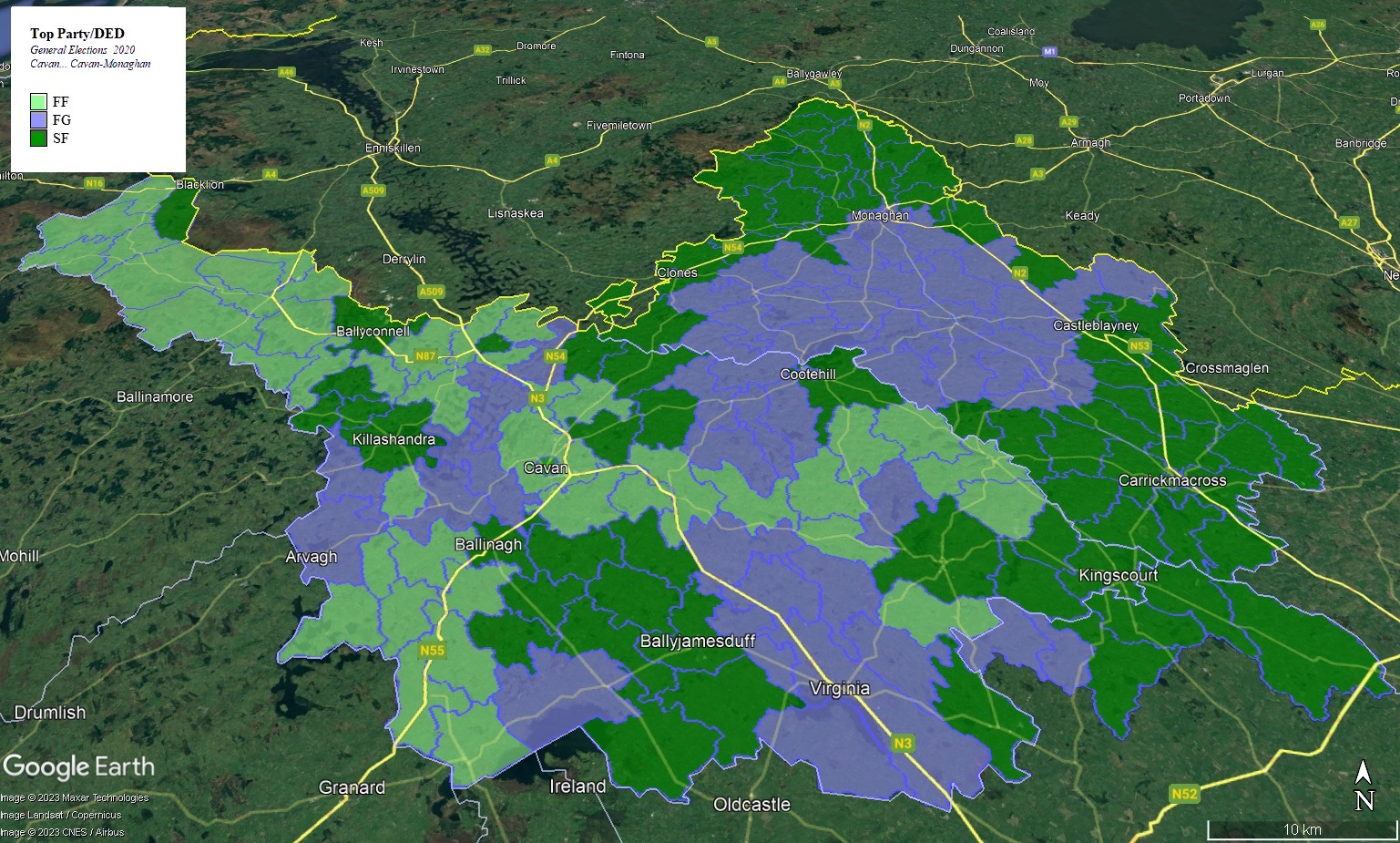
The pattern of support is quite different across the two counties. Fianna Fáil top the poll in areas across Cavan (particularly in the west) – they didn’t top the poll in a single DED in Monaghan. Also the Cavan side of the map sports a patchwork of poll-topping parties, while in Monaghan, the poll-toppers are sorted into three sizeable blocs – Fine Gael in the centre of the county and Sinn Féin in the North and South.
TABLE 6 – PARTY SUPPORT BY LEA
| SF | FG | FF | AON | OTH | IND | % | |
| B’borough-Cootehill | 29% | 25% | 30% | 11% | 4% | 0% | 20% |
| Ballyjamesduff | 33% | 28% | 28% | 5% | 5% | 0% | 19% |
| Cavan-Belturbet | 33% | 21% | 33% | 4% | 7% | 0% | 16% |
| C’macross-C’blayney | 48% | 22% | 19% | 3% | 6% | 0% | 16% |
| Ballybay-Clones | 35% | 39% | 17% | 3% | 4% | 1% | 15% |
| Monaghan | 44% | 27% | 20% | 5% | 4% | 0% | 16% |
| TOTAL | 37% | 27% | 25% | 5% | 5% | 0% |
As can be seen Sinn Féin were notably stronger in Monaghan where they outpolled Fianna Fáil 2-to-1 whereas they were on an even pegging with them in Cavan. Sinn Féin’s traditional heartland is in the north of the county, but in 2020 they actually polled better in the south (the Carrickmacross-Castleblayney area)
The small loss of votes from the seven Meath DEDs would make very little difference to the overall result, so on the above numbers this constituency would return two Sinn Féin TDs, two Fianna Fáil and one Sinn Féin.
LONGFORD-WESTMEATH (5 seats)
The constituency of Longford-Westmeath would simply consist of the counties of Longford and Westmeath. There are three large towns in the constituency – Longford, Athlone and Mullingar.
TABLE 7 – LONGFORD-WESTMEATH CONSTITUENCY DEDS
| COUNTY | DISTRICT ELECTORAL DIVISIONS | POPULATION |
| Longford | ALL | 46,634 |
| Westmeath | ALL | 95,840 |
The new Longford-Westmeath would be the first time the constituency has been a five-seater since 1957 when Sinn Féin won a seat from Fianna Fáil at the height of the IRA border campaign – Fianna Fáil had held three of the five seats in the constituency since its reincarnation in 1948.
Longford-Westmeath has hosted a few interesting characters down the years – Brian Lenihan Snr ran for Fianna Fáil in 1954, but came fourth of the four Fianna Fáil candidates – he later won a seat in Roscommon in 1961, moving to Dublin West in 1977. Eleven years later, his father Patrick took the last seat in Longford-Westmeath by 13 votes from Independence-era veteran Sean McEoin – the only time a father followed his son into the Dáil.
Gerry L’Estrange first ran for the Dail in 1944 for Clann Na Talmhan in Meath-Westmeath and then in 1948 for Fine Gael. On both occasions he polled poorly. He didn’t run again until 1965 when he took a seat for Fine Gael and in 1981 was finally at the age of 64 was appointed a Junior Minister. Persistence finally had its reward.
Joe Sheridan ran three times for Fine Gael without success before winning first time out as an Independent in 1961. He held the seat until retiring in 1977.
MAP 3 – PROPOSED LONGFORD-WESTMEATH CONSTITUENCY
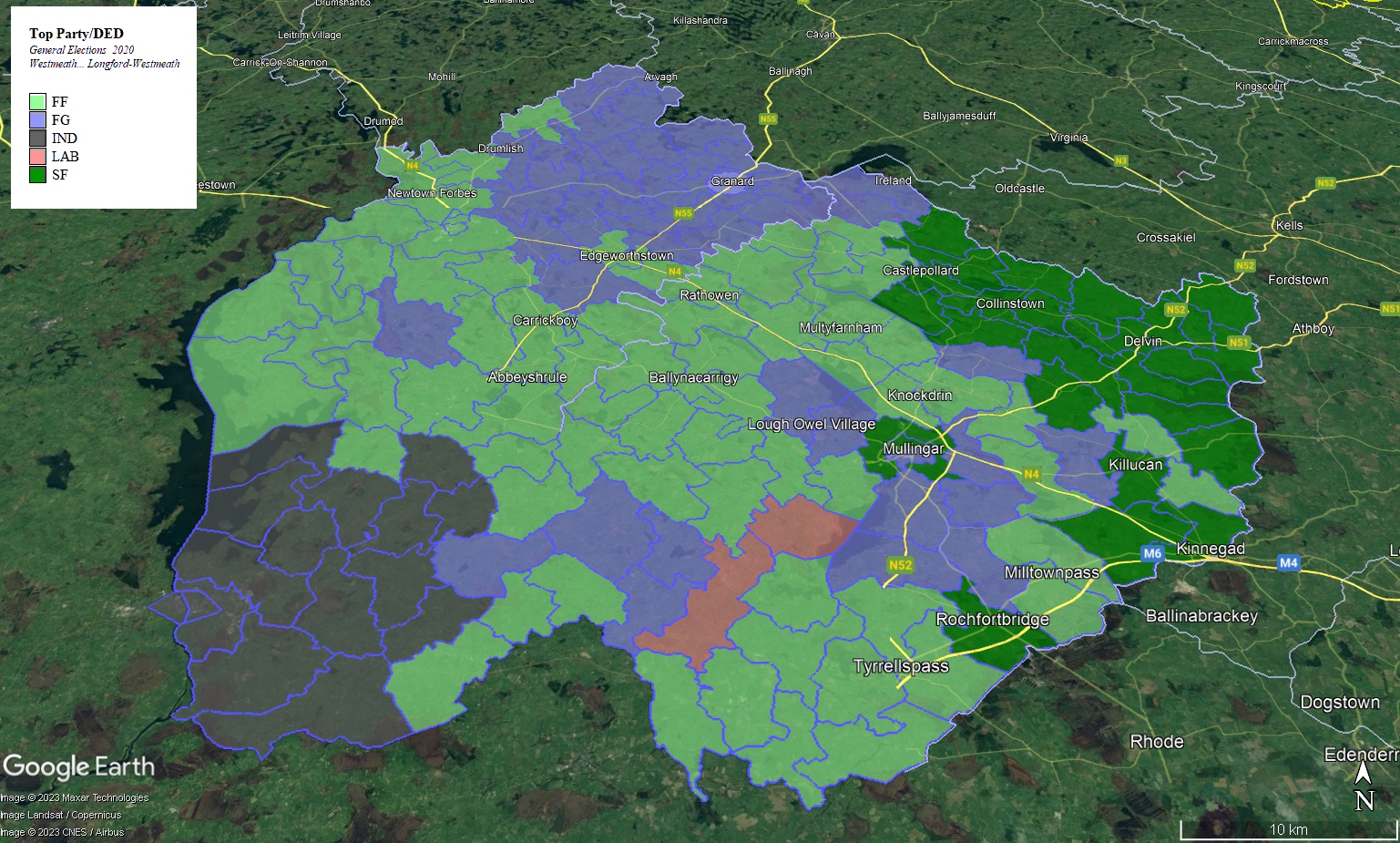
Previously Fianna Fáil support tended to be stronger – in both local and national elections in the north of Longford, while Fine Gael tended to be stronger in the south – however that pattern was reversed in 2020.
Sinn Féin topped to polled in every DED that voted in Meath West in 2020. However, they also polled strongly in neighbouring parts of Westmeath, topping the poll as well in Mullingar.
TABLE 8 – PARTY SUPPORT BY LEA
| SF | FG | FF | OTH | IND | % | |
| Mullingar | 27% | 27% | 31% | 12% | 2% | 17% |
| Kilbeggan | 18% | 22% | 33% | 14% | 12% | 16% |
| Athlone | 19% | 15% | 12% | 12% | 43% | 16% |
| Ballymahon | 17% | 25% | 40% | 5% | 13% | 11% |
| Granard | 18% | 44% | 28% | 5% | 4% | 11% |
| Longford | 18% | 27% | 45% | 6% | 4% | 11% |
| Kinnegad (L-W) | 28% | 25% | 31% | 13% | 3% | 11% |
| Kinnegad (MW) | 36% | 25% | 21% | 18% | 0% | 7% |
| TOTAL | 22% | 26% | 29% | 11% | 12% |
Sinn Féin were notably stronger in east Westmeath (the Mullingar area and the two parts of the Kinnegad area) than elsewhere in the constituency where they still polled a creditable 17-19%.
On these figures, the extra seat should ensure two seats for Fianna Fáil and one each for Fine Gael and Sinn Féin, with the last seat probably going to an Independent rather than a second seat for Fine Gael.
Roughly two-thirds of the votes (ie 4 quotas) were cast in Westmeath and one third in Longford (2 quotas). On paper, this means that the last seat could be fought between a Longford candidate and a Westmeath candidate. However – generally speaking – smaller counties in a two-county constituency tend to “leak” votes to major candidates from the larger county. For instance according to the tallies, 65% of the votes were cast in Westmeath in 2020, but Westmeath candidates took 72% of the vote. That said, it is still likely – on the 2020 count – that the last seat would be contested between a Longford Fine Gael candidate and a Westmeath Independent candidate.
LOUTH NORTH (3 seats)
The constituency of Louth North would consist of the north and much of the centre of Louth, comprising Dundalk, the Carlingford Peninsula and Ardee.
TABLE 9 – LOUTH NORTH DEDs
| LEA | DEDs | POPULATION |
| Dundalk-Carlingford and Dundalk South | ALL | 64,024 |
| Ardee (pt) | ALL except Collon, Dunleer, Mullary | 18,307 |
The reason why I’ve grouped Dondalk-Carlingford and Dundalk South together in the above table is that the Local Electoral boundaries run through several of the Dundalk Urban and Rural DEDs, therefore making it impossible to quantify the current population of the two Electoral Areas.
Louth has been a constituency continuously since 1923. Up to 1961 the constituencywas a three seater and contiguous with the county. From then until 1977, Ardee and its environs were transferred to Monaghan; in 1977 the Inishkeen area of Monaghan was instead transferred to Monaghan to make it a four seater. From 1981 to 2011 the county and the constituency were again contiguous as a four seater. In the latter year, it expanded into a five seater including the part of east Meath close to Drogheda.
Frank Aiken was first elected in 1923 and represented the constituency for 50 years. In 1927, trade unionist James Coburn was elected for the National League and later joined Fine Gael on its foundation, being re-elected until his death in 1953. James Connolly’s son Roddy won a seat for the party in 1943 and 1948.
In 1954 Fine Gael managed to take two of the three seats; Fianna Fáil then held 2 out of 3 continuously from 1957 until 1977 when they took 3 out of 4 which feat they repeated in February 1982. In 1981 hunger-striker Paddy Agnew took a seat. November 1982 saw the entry of Fine Gael firebrand Brendan McGahon and the first Labour TD in thirty years Michael Bell. From then until 2002, the constituency returned 2 Fianna Fáil, 1 Fine Gael and 1 Labour TD; in the latter year Sinn Féin replaced Labour.
MAP 4 – LOUTH NORTH CONSTITUENCY
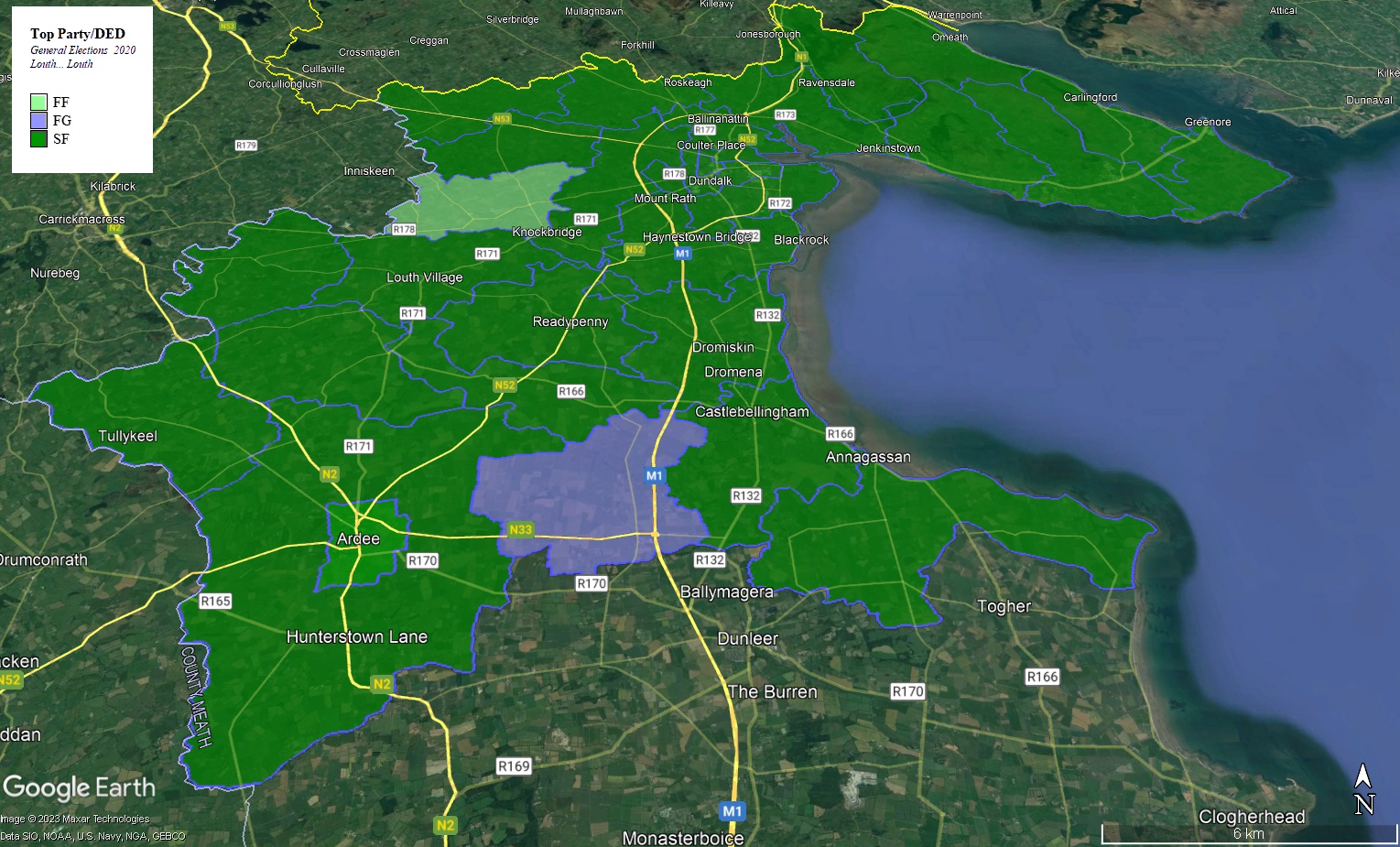
Sinn Féin dominated the area, the only exceptions being Knockbridge (Fianna Fáil) and Stabannon (Fine Gael). Some urban polling statons rose as high as 70% for Sinn Féin.
TABLE 10 – PARTY SUPPORT BY LEA
| SF | FG | FF | GP | OTH | IND | % | |
| Dundalk-Carlingford | 45% | 12% | 12% | 11% | 6% | 16% | 40% |
| Dundalk South | 43% | 13 | 12% | 11% | 5% | 7% | 41% |
| Ardee (pt) | 40% | 20% | 16% | 6% | 6% | 11% | 19% |
| TOTAL | 43% | 14% | 13% | 10% | 5% | 16% |
Over 80% of the vote would be cast in Dundalk and its wider environs making it highly likely that all three TDs would hail from there.
On the above figures, Sinn Féin would be likely to take two seats, with the remaining seat likely to be contested between Fianna Fáil, Fine Gael and Independents.
LOUTH SOUTH (3 seats)
The constituency of Louth South would consist of south Louth, the town of Drogheda and a small urbanised part of East Meath.
The part in Louth includes the towns of Termonfeckin and Clogherhead, the part includes Julianstown, Laytown and Bettystown.
TABLE 11 – LOUTH SOUTH DEDs
| LEA | DEDs | POPULATION |
| Drogheda Urban | ALL | 28,344 |
| Drogheda Rural | ALL | 19,759 |
| Laytown-B’town (pt) | St. Mary’s (pt), Julianstown | 27,912 |
| Ardee (pt) | Collon, Dunleer, Mullary | 6,950 |
Besides Drogheda Urban, sizeable parts of the town lie in Laytown-Bettystown and Drogheda Rural.
MAP 5 – LOUTH SOUTH CONSTITUENCY
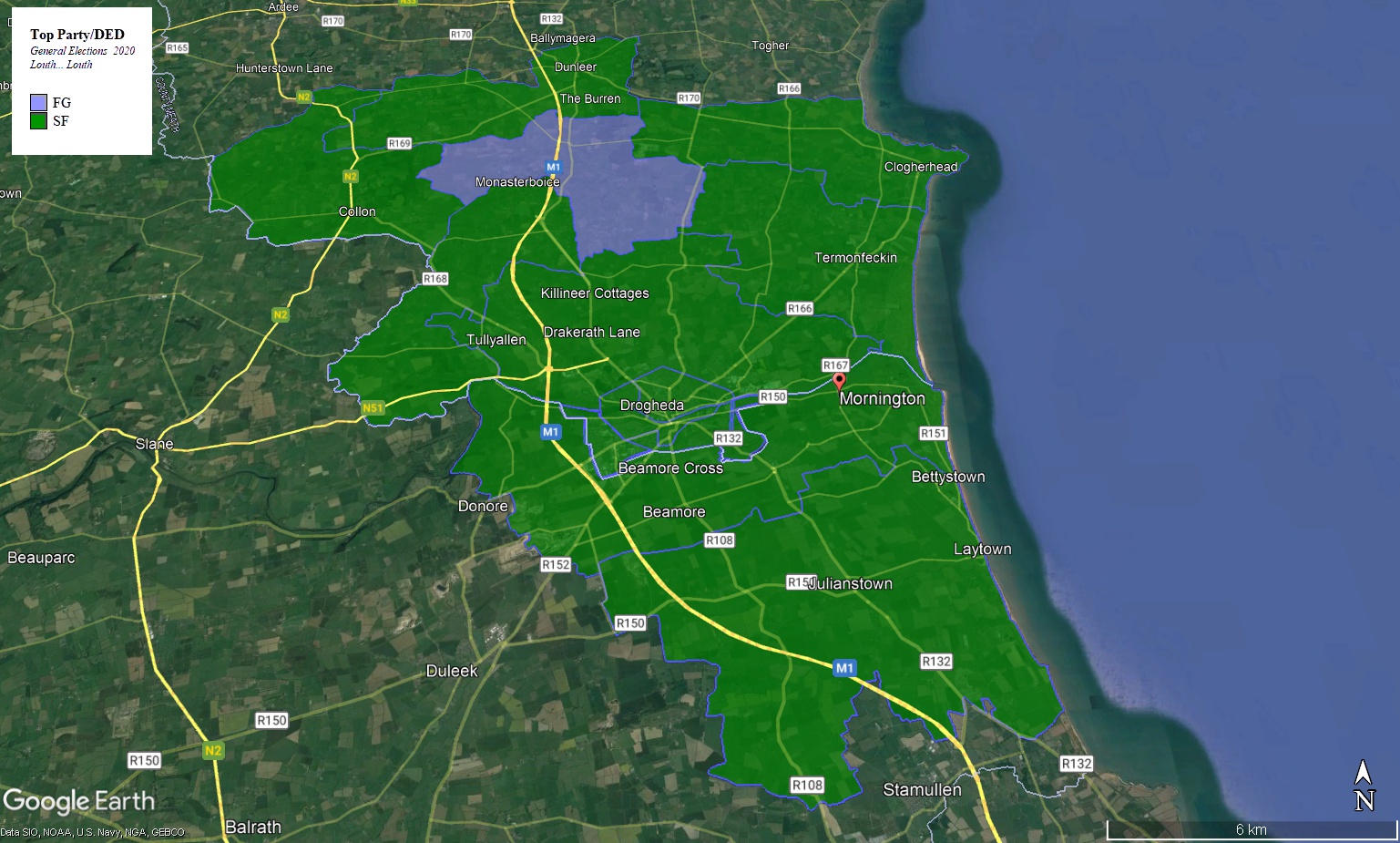
Sinn Féin dominated the area, the only exceptions being the rural area of Mullary which plumped for Fine Gael.
TABLE 12 – PARTY SUPPORT BY LEA
| SF | FG | FF | LAB | OTH | IND | % | |
| Drogheda Urban | 50% | 11% | 11% | 18% | 7% | 3% | 36% |
| Laytown-B’town (pt) | 36% | 20% | 15% | 14% | 12% | 3% | 29% |
| Drogheda Rural | 42% | 16% | 14% | 15% | 10% | 3% | 25% |
| Ardee (pt) | 36% | 21% | 17% | 7% | 10% | 8% | 10% |
| TOTAL | 42% | 16% | 14% | 15% | 9% | 3% |
Sinn Féin tended to poll higher in Drogheda rather than the surrounding communities and rural areas.
On the above figures, Sinn Féin would be likely to take two seats, with the remaining seat likely to be contested between Fianna Fáil, Fine Gael and Labour.
MEATH EAST (4 seats)
The constituency of Meath East would remain virtually the same except for the addition of seven DEDs in Meath West.
TABLE 13 – LOUTH SOUTH DEDs
| Constituency | DEDs | POPULATION |
| Meath East | ALL | 98,662 |
| Meath West (pt) | Gallow, Galtrim, Kilcooly, Laracor, Rahinstown, Summerhill in TRIM and Kilmessan in Dunshaughlin | 6,785 |
| Cavan-Monaghan (pt) | ALL DEDs in County Meath | 4,110 |
About two-thirds of the population live in the Ashbourne and Ratoath Electoral Areas, which are home to the large commuter towns of Ashbourne, Dunboyne and Ratoath. The other main town is Kells in the far north-west.
Between 1923 and 1933 Meath had three seats. Between the 1937 and 1944 elections, it was part of a five seat Meath-Westmeath, before becoming a standalone constituency again in 1948. It was a four seater in 1977 and a five seater from 1981 until 2007.
Between September 1927 and 1951 only Fianna Fáil and Cumann na nGaedhal Fine Gael TDs were elected for Meath and Meath-Westmeath. James Tully was elected for Labour in 1954, defeated in 1957, but returned in 1961 when Labour outpolled Fine Gael; they did so again in 1965. In fact no other party than Fianna Fáil, Fine Gael or Labour won a seat in Meath until Sinn Féin’s Peadar Toibin in Meath West in 2011.
MAP 6 – MEATH EAST CONSTITUENCY
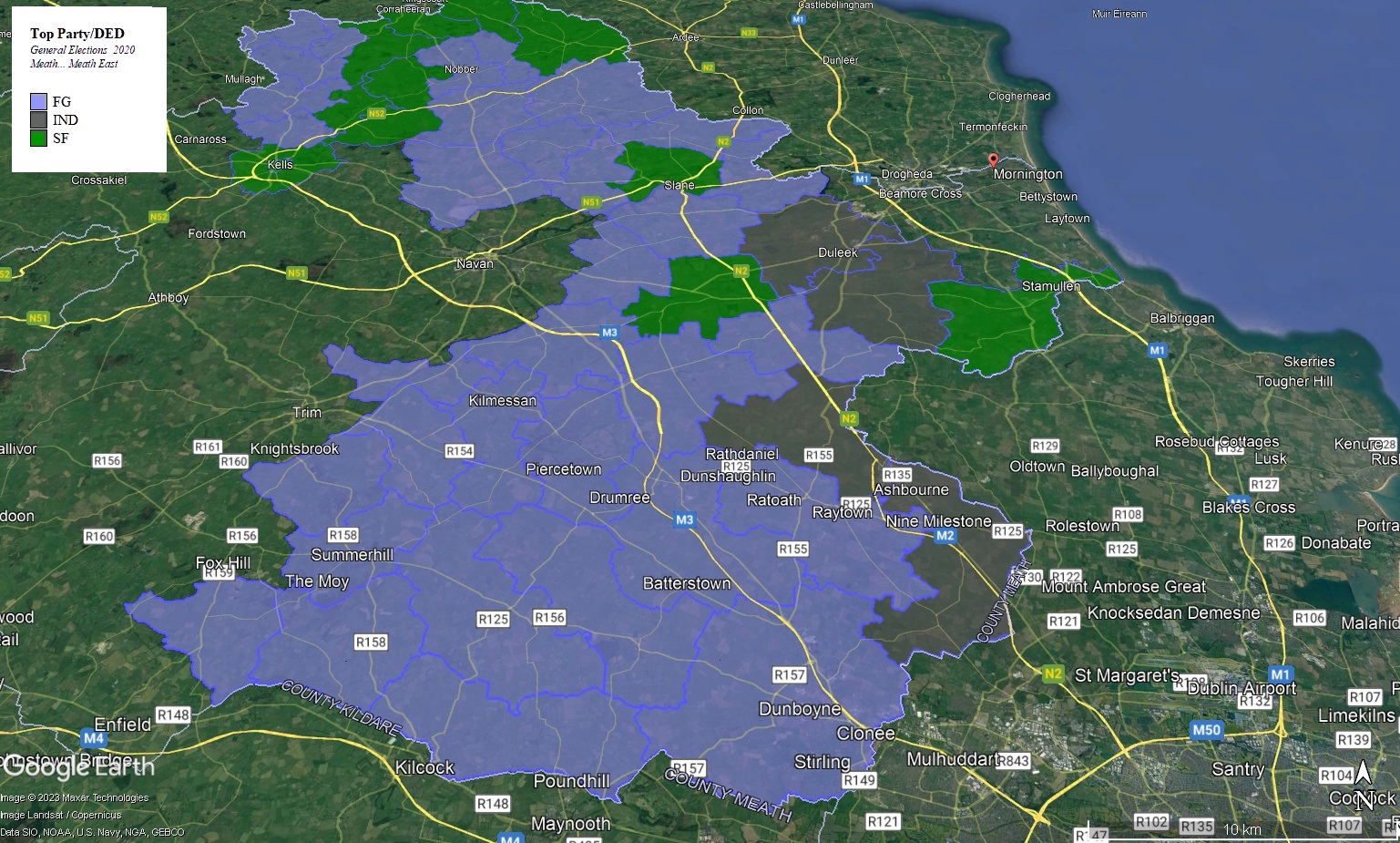
Fine Gael topped the poll across much of the rural part of the constituency as well as Ratoath and Dunboyne. Independents took the largest share in Ashbourne, while Sinn Féin were the largest party in Kells.
TABLE 14 – PARTY SUPPORT BY LEA
| SF | FG | FF | GP | OTH | IND | % | |
| Ratoath | 20% | 33% | 21% | 11% | 8% | 6% | 33% |
| Ashbourne | 24% | 24% | 15% | 7% | 7% | 23% | 30% |
| Kells (pt) | 31% | 32% | 21% | 4% | 10% | 2% | 15% |
| Laytown-B’town (pt) | 27% | 21% | 17% | 5% | 7% | 22% | 11% |
| Trim (pt) | 18% | 39% | 18% | 7% | 17% | — | 5% |
| Kells (C-M) | 35% | 24% | 29% | 3% | 10% | — | 5% |
| Ratoath (MW) | 19% | 35% | 12% | 5% | 30% | — | 1% |
| TOTAL | 25% | 28% | 19% | 7% | 9% | 12% |
The Sinn Féin vote was stronger in the north of the constituency.
On the above figures, Sinn Féin, Fine Gael and Fianna Fáil would all take one seat; but it’s actually hard to call where the last seat would go – possibly the Green party edging out ahead a second Fine Gael seat.
MEATH WEST (4 seats)
The constituency of Meath East would remain virtually the same except for the loss of seven DEDs to Meath West
TABLE 15 – Meath West DEDs
| Constituency | DEDs | POPULATION |
| Meath West (pt) | ALL except Gallow, Galtrim, Kilcooly, Laracor, Rahinstown, Summerhill in TRIM and Kilmessan in Dunshaughlin | 82,682 |
The largest town in the constituency is Navan; the only other major town is Trim to the South-West.
MAP 7 – MEATH WEST CONSTITUENCY
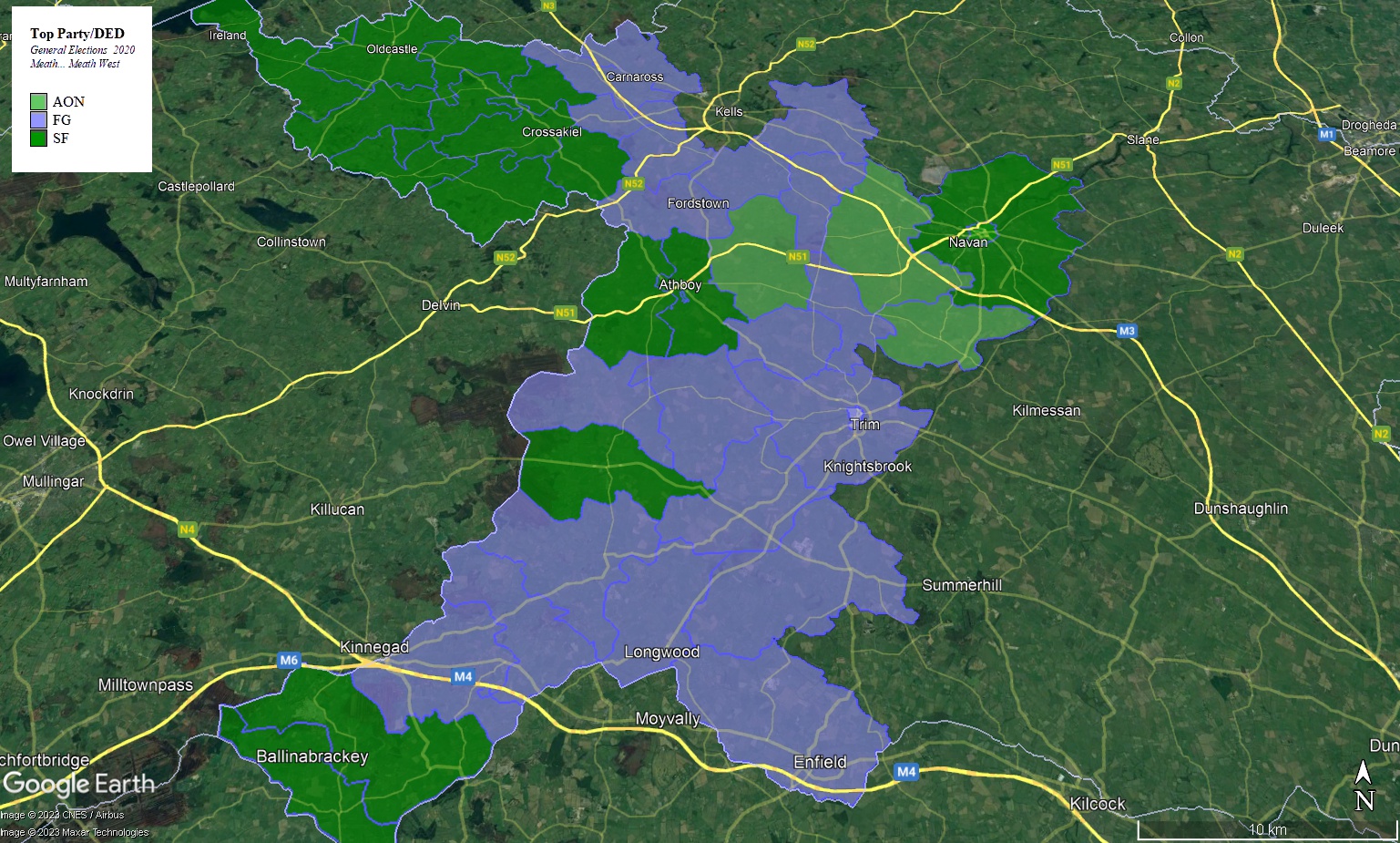
Sinn Féin topped the poll in Navan, and the north-west of the constituency, while Fine Gael topped the poll in Trim and much of the rural areas in the South.
TABLE 16 – PARTY SUPPORT BY LEA
| SF | FG | FF | AON | OTH | IND | % | |
| Navan | 29% | 16% | 16% | 27% | 10% | 0% | 40% |
| Trim (pt) | 26% | 32% | 13% | 16% | 12% | 0% | 37% |
| Kells (pt) | 40% | 25% | 18% | 11% | 6% | 0% | 24% |
| TOTAL | 30% | 24% | 16% | 19% | 10% | 0% |
The Sinn Féin vote was stronger in the north of the constituency, while Fine Gael was clearly stronger in the South.
On the above figures, Sinn Féin, Fine Gael and Aontu would probably all take one seat; but Fianna Fáil might be slightly closer to Fine Gael on the final count.
CONCLUSION
Below is the suggested set of six possible constituencies to replace the current five in South Leinster. Essentially Longford-Westmeath and Cavan-Monaghan would become five seat constituencies, each consisting exclusively of their constituent counties, there would be a small transfer of area from Meath West to Meath East allowing the latter to become a four seater and the current Louth Constituency would become two three-seaters. A similar situation pertains to Carlow and Kilkenny. Kildare would retain eight seats, albeit Kildare North gaining a seat at the expense of South Kildare.
TABLE 17 – SUGGESTED CONSTITUENCIES
| CONSTITUENCY | SEATS | POPULATION | VAR178 | SF | FG | FF | OTH | IND |
| Cav.-Monaghan | 5 | 146,033 | +1.5% | 37% | 27% | 25% | 10% | 0% |
| L’ford-W’meath | 5 | 142,160 | -1.2% | 22% | 26% | 29% | 11% | 12% |
| Louth North | 3 | 82,311 | -4.7% | 43% | 14% | 13% | 15% | 16% |
| Louth South | 3 | 82,965 | -3.9% | 43% | 16% | 14% | 24% | 3% |
| Meath East | 4 | 109,417 | -4,7% | 25% | 28% | 19% | 16% | 12% |
| Meath West | 3 | 82,682 | -4.2% | 30% | 24% | 16% | 29% | 0% |
There would be three population transfers totalling 20,305 – roughly 1 in 32 of the population in the region. Two of these transfers move populations into constituencies aligned with their counties , and the third is an exchange between constituencies in the same county.
Firstly, the eastern portion of County Westmeath currently in Meath West totalling 9,410 population would move back into Longford-Westmeath. Seven DEDs in north Meath currently in Cavan-Monaghan would move back into Meath East (population 4,110).
And finally seven DEDs in Meath West would move into Meath East (population 6,785).
A population of 27,912 people would live in a constituency (Louth South) not primarily based in their county (Meath); however, a significant minority of that number live in the southern part of Drogheda, and most of the rest live in nearby communities.
MAP 8 – NORTH LEINSTER
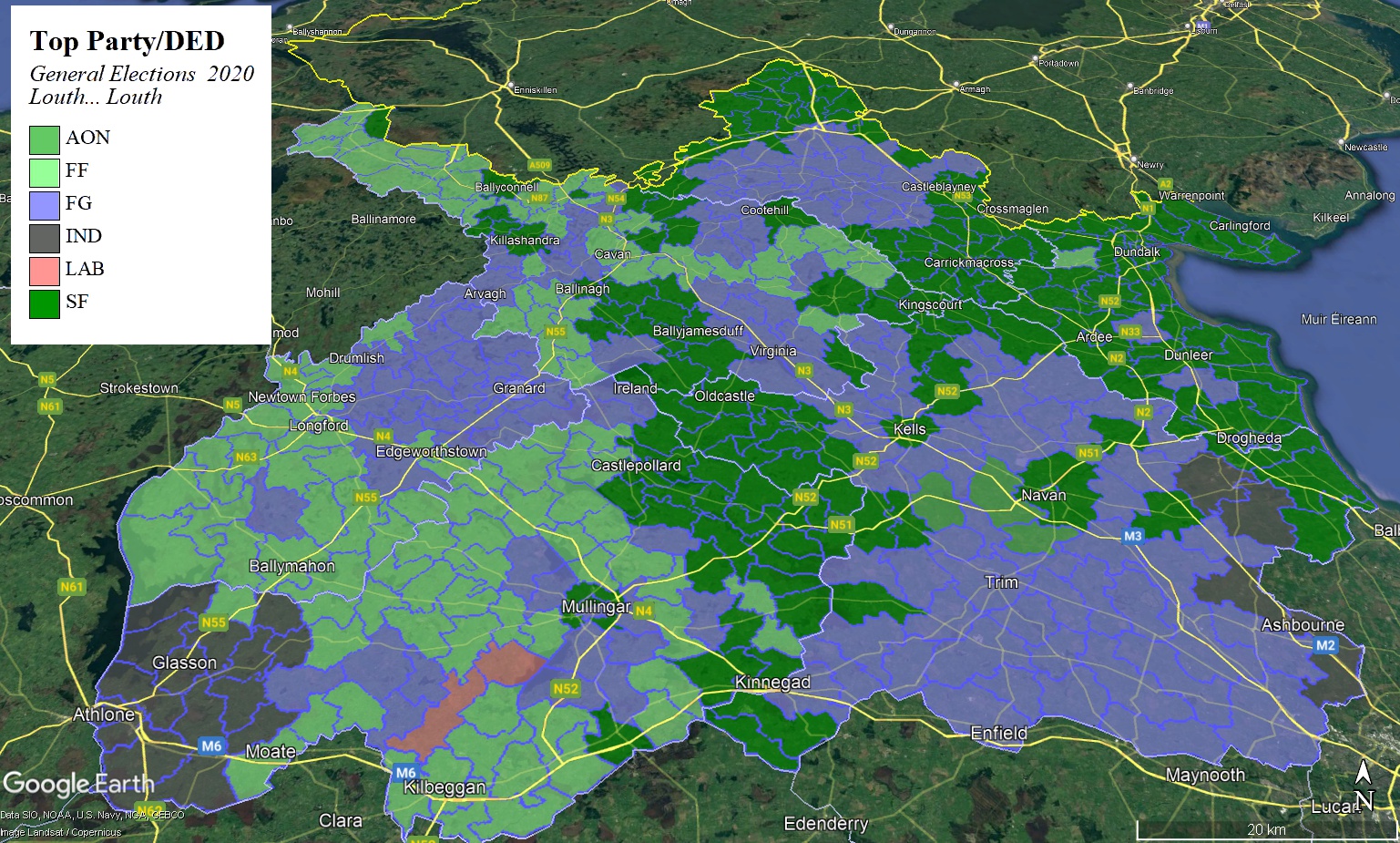
ALTERNATIVES IN MEATH AND LOUTH
In this post I am going to look at reconfiguring Louth as a 5 seater, and Meath as two Four seaters.
Louth as a county can support five seats in both 178 and 180 seat Dails; the downside is that about a quarter of Drogheda lies in County Meath as well as the nearby urban communities.
LOUTH (5 seats)
Louth would consist of the whole county of Louth – with the southside of Drogheda and Laytown and Bettystown all going into the Meath East constituency.
MAP 9 – LOUTH
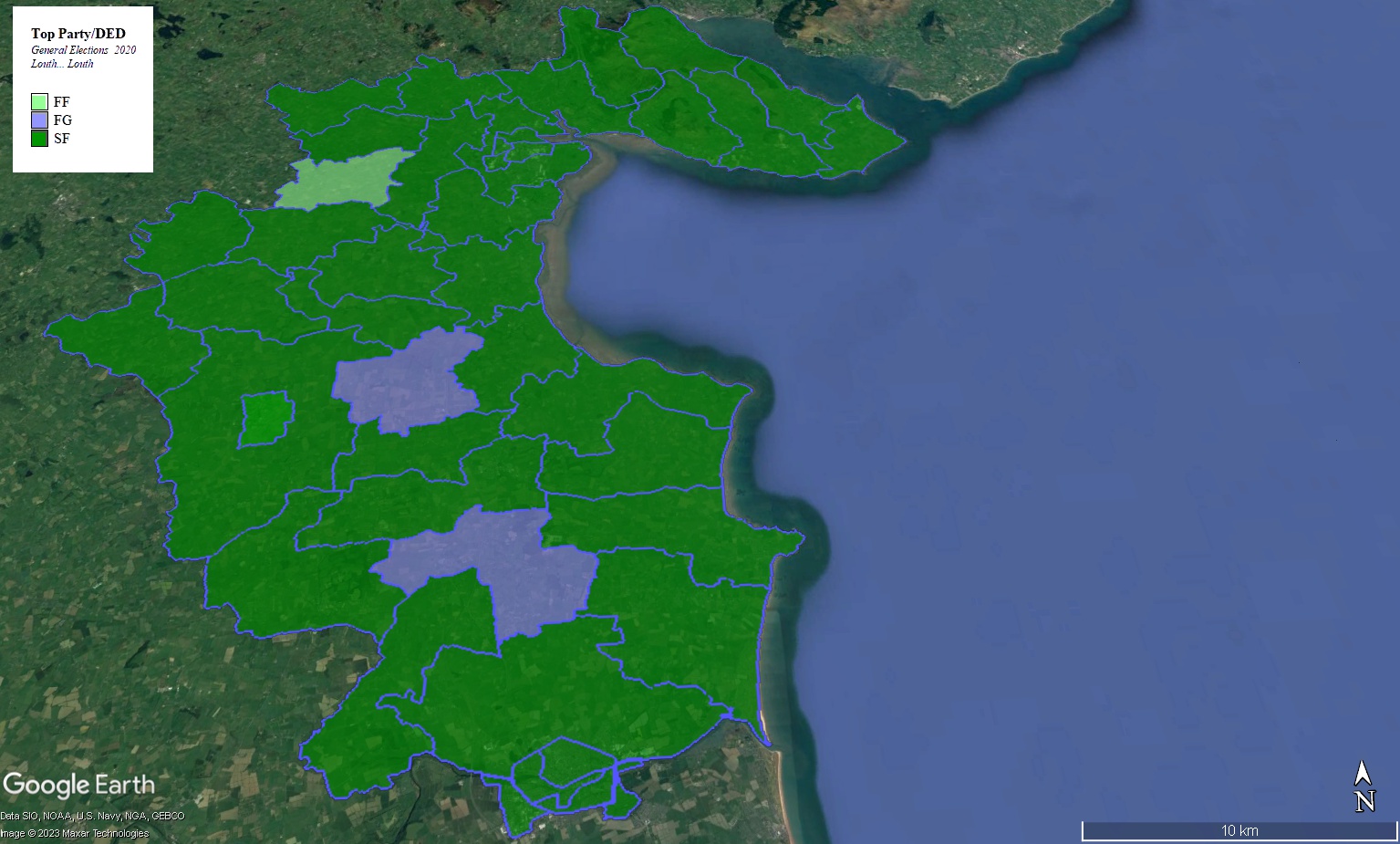
The Labour seat here would be endangered with the most likely beneficiary being either Fianna Fáil or the Green Party.
MEATH WEST (4 seats)
Meath West would consist of the current constituency of Meath West (within Meath as well as the parts of Kells Electoral Area that were in Meath East and Cavan-Monaghan in 2020 and a small rural area in the west of the Laytown-Bettystown Local Electoral Area.
MAP 10 – MEATH WEST
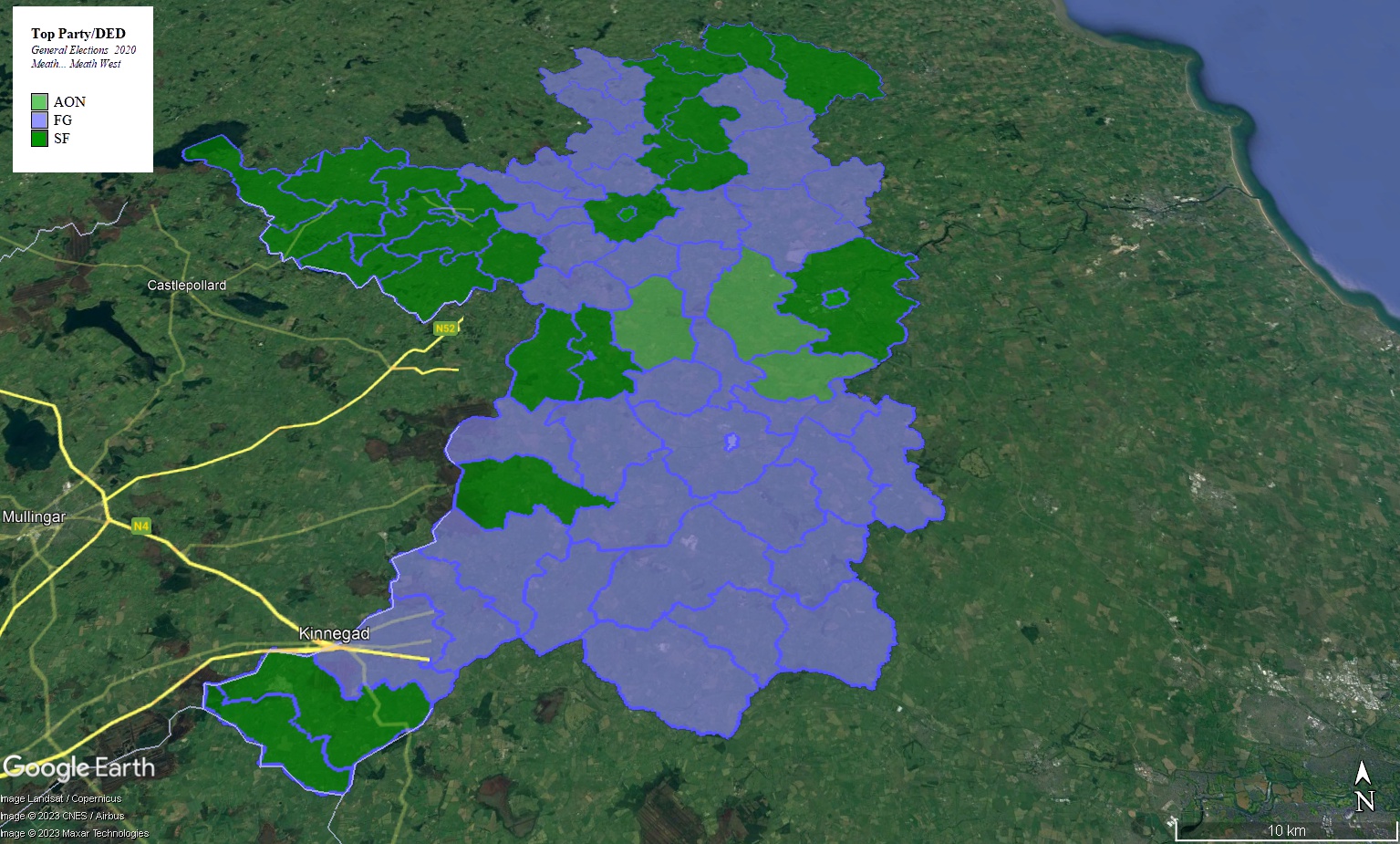
The result would likely be one seat each for Fianna Fáil, Fine Gael, Sinn Féin and Aontu.
MEATH EAST (4 seats)
Meath East would cede its territory in the Kells Electoral Area and a small part of Laytown-Bettystown Electoral area, but in return would receive the southside of Drogheda (which lies within Meath) and the towns of Laytown and Bettystown.
MAP 11 – Meath East

There would be one guaranteed seat each for Fianna Fáil, Fine Gael and Sinn Féin, with the last seat between the Greens and a 2nd Fine Gael candidate
TABLE 18 – SUGGESTED CONSTITUENCIES
| CONSTITUENCY | SEATS | POPULATION | VAR178 | SF | FG | FF | OTH | IND |
| Louth | 5 | 139,100 | -3.4% | 43% | 15% | 13% | 18% | 11% |
| Meath East | 4 | 110,112 | -4.4% | 26% | 26% | 17% | 18% | 13% |
| Meath West | 4 | 110,134 | -4.3% | 30% | 26% | 17% | 27% | 0% |
